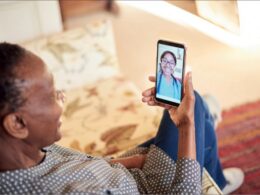Digital stethoscopes, otoscopes, thermometers, mobile ultrasounds and ECGs, miniature labs — measuring advanced health parameters is becoming increasingly accessible.
Popular instruments used in general medicine are being replaced by smart, digital, and mobile equivalents. They are more accurate, enabling doctors to transfer data directly to electronic medical records and gain a more in-depth insight into vital signs and human anatomy.
ICT&health
ARTUR OLESCH
March 2, 2021
The last century witnessed colossal progress in medical technologies. Doctors were given new opportunities to diagnose and treat patients. The symbol of this revolution was the stethoscope, invented in 1816 by Rene Laennec. In the beginning, it was a simple tube used to auscultate the patient, but then later, the stethoscope became the most recognizable attribute of a doctor, worn around the neck.
Some 200 years later and the stethoscope has a new, digital successor. One example is the Eko Core, an electronic stethoscope certified by the U.S. Food and Drug Administration (FDA) and bearing the European CE mark.

The device can follow and register the heart and respiratory sounds, reducing noise and increasing the signal strength by a factor of 40.
It connects wirelessly to a smartphone and allows the results and recordings to be analyzed in a mobile application.
All data can be sent to the electronic medical record or consulted with other specialists.
Moreover, Eko Core has a manual mode available for simple examinations.
It is larger than its analogue predecessor, but this is the price of increased functionality.
With a special extension, the stethoscope can be turned into an ECG device.
The patient can use the DUO ECG, for example, during online consultations (telemedicine). It is also worth mentioning KardiaMobile from AliveCor — clinically‑validated a 6-lead personal ECG monitor to test the patient remotely.
All you need to do is place your fingers on a small plate placed on the phone and hold them there for 30 seconds.
Digital medical devices: quick on-the-spot testing
The most common tests ordered by doctors are blood pressure and body temperature.
With the COVID-19 pandemic, many health care facilities required their front desk receptionists to take the patients’ temperature using an electric thermometer.
Contactless thermometers are more hygienic and the results are available within few seconds.
Mercury thermometers were quickly replaced and the prices for their electronic counterparts dropped significantly.
Progress can also be observed in blood pressure measurement.
Digital screens have replaced analogue pointers. No other test has become as popular as blood pressure measurement in recent years. Just ten years ago, it could only be done by a doctor or a nurse.
Within a few years, it will be possible to measure blood pressure and hematological parameters with a smartwatch on the wrist or in portable cabins with even more powerful diagnostic capabilities.
Already today, smartwatches offer increasing numbers of medical functionalities, including monitoring of ECG, atrial fibrillation, blood oxygen levels.
According to recent reports, Samsung and Apple are planning to include a glucose monitoring option in their smartwatches, a sought-after feature for many patients worldwide.
Some tests performed only in laboratories can now be carried out on-the-spot, in a doctor’s office.
For example, Siemens Healthineers epoc NXS Host measures 14 blood components. It fits into your hand and consists of a small testing station and an Android smartphone, which manages the process of reading and sending the data.
The epoc NXS Host needs only 92 μL of blood for testing, and the measurement takes less than a minute.

Laboratory in a pocket
Due to the COVID-19 pandemic, many health care facilities began to offer quick coronavirus tests.
The results of a molecular test carried out using the Abbott ID Now are available within 5 minutes (or 13 minutes for negative results).
The small laboratory station measures just 8,5 x 11 inches.
Abbott also offers versions that detect flu viruses, RSV (which is the leading cause of respiratory diseases in children), and strep A (which can cause sore throats, for example).
In this way, a doctor can immediately determine the cause of the disease and start treatment without prescribing unnecessary antibiotics.
Traditional otoscopes are also disappearing from the market, replaced by digital equivalents featuring high-resolution cameras, making it possible to analyze an image on large computer screens and record videos (for example, Firefly or WiscMed).
Digital otoscopes, stethoscopes, and ECG devices have one more advantage.
They can be extended with artificial intelligence systems, helping to detect even the most subtle anomalies, often invisible to the human eye and inaudible to the human ear, making diagnoses more precise.
Finally — mobile ultrasound devices. No more big testing stations by the patient’s bed. A handy device can now be connected to a smartphone or a tablet.
Apart from the highest image quality, there are many more benefits for doctors: the image can be saved and sent to other doctors for assessment, the data transfer is safe, and the device is fully mobile, which makes it possible to examine a patient and save the results from a home visit.
The leader in this segment is Philips with its Lumify.
Capturing data that matter
Digital diagnostic devices make it possible to save all the relevant data without wasting any information that could prove valuable for diagnostic or treatment.
The amount of data soon will be no longer a problem because AI systems can analyze large data sets to search for correlations and trends. Access to data also opens the door to personalized medicine.
Moreover, thanks to digital diagnostic devices, doctors no longer have to enter the data into electronic medical records manually.
These will be collected from smart devices, including those used by the patient.
Will the doctor’s office of the future include nothing more than a doctor, a computer or a tablet, and one device that can carry out all the required tests?
It seems that other technical equipment will be unnecessary.
Originally published at https://ictandhealth.com on March 2, 2021.












